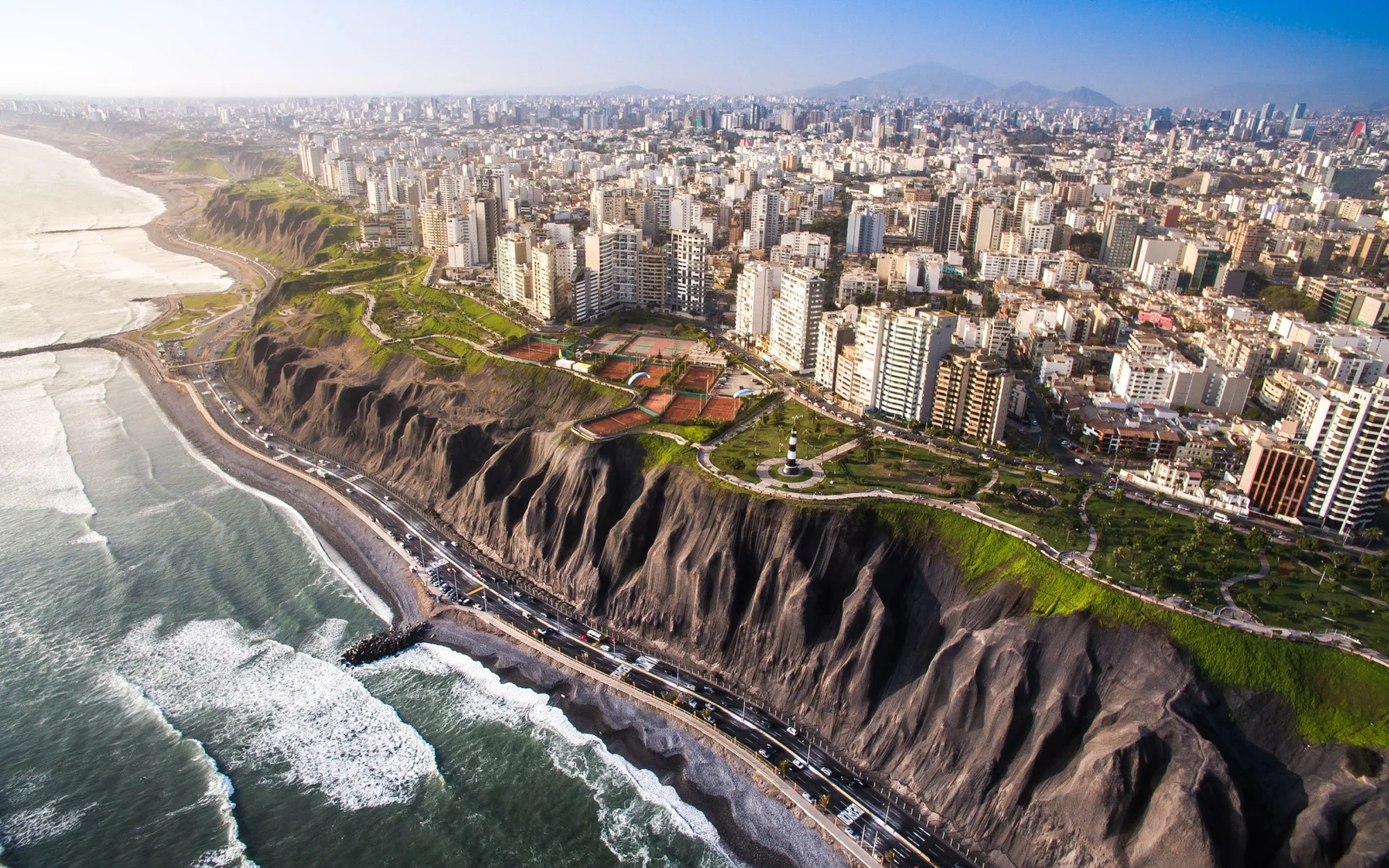Lima is one of those South American cities that captures the imagination. Over 2 million people visit the Peruvian capital every year. When you look at everything that Lima has to offer, it’s no wonder that so many people vacation here annually.
Visitors can tour historic colonial architecture such as the Lima Main Square, pre-Colombian ruins such as the Huaca Pucllana, which even predates the Incas, or step into the present day and enjoy the metropolis’s amazing food culture and nightlife.
But while this storied city has plenty to offer tourists, is Lima safe to visit? Here’s our take.
Is Lima, Peru, Safe to Visit in 2024?
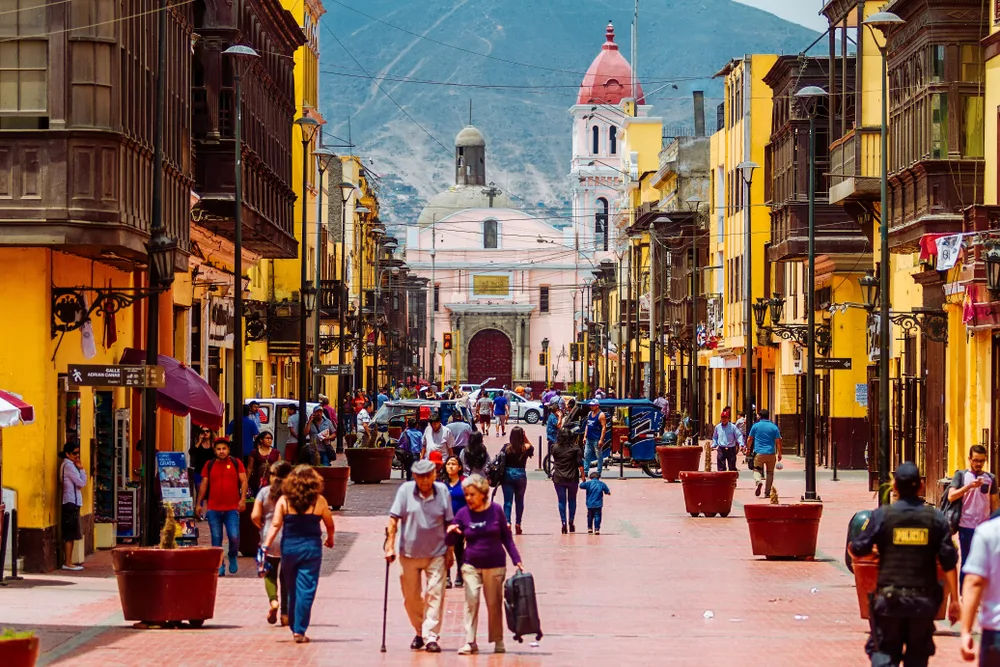
Lima, Peru – February 2, 2018: Daily image of passers-by strolling through the streets of Rimac, in the metropolitan area of Lima, Peru/Simon Mayer/Shutterstock
No. Lima is not the safest place to visit, especially in 2023. The city has high rates of crime, including violent crime, which often affects tourists. Recent protests are gripping the country as well.
Although most of the civil unrest is concentrated in the south, protests can and will erupt in Lima as well.
The main source of concern for travelers right now is the widespread civil unrest. Protests have been going on since December 2022, when the Peruvian Congress removed president Pedro Castillo for allegedly trying to rebel against the government.
This triggered long-standing simmering tensions between the Peruvian elite and the poorer people in the south who were Castillo’s base.
There have been ongoing clashes, strikes, and roadblocks, with many people criticizing the government’s strict response, which led to the deaths of nearly 50 protesters.
Most of the protests are concentrated in the country’s southern regions. Many foreign governments, such as Canada’s, have regional advisories that urge travelers to reconsider all but non-essential travel to the southern cities of Arequipa, Cusco, Ica, and Puno.
Many tourist destinations and airports have closed to make it through the unrest. The Peruvian government created a Tourist Protection Network to help foreigners in those regions safely leave the country.
However, just because Lima isn’t under the strictest of advisories at the moment doesn’t mean that it is a safe place to visit. Since it is the capital, it sees its fair share of protests and unrest as well.
For many of the protesters, Lima represents everything wrong with the country, especially the out-of-touch elite. Demonstrations could happen at any time, and they could turn violent.
The political situation has made a visit to Lima riskier now than it used to be, but tourists have always had to be vigilant when it comes to crime.
The United States State Department has all of Peru under a “Level 3: Reconsider Travel” advisory, not just because of civil unrest but also because of crime. Crime rates in Lima are fairly high.
Your usual petty theft and scamming found in most tourist destinations is prevalent here. The real problem is the fairly high violent crime rate, which does affect tourists. Tourists have been victims of armed robbery, assault, express kidnappings, and even rape.
To recap, the main dangers affecting tourists in Lima currently are:
- Civil unrest
- Pickpocketing
- Scams
- Armed robbery
- Assault
- Sexual assault
While the crime rate alone might give you pause, the situation is even worse now considering the recent civil unrest. It’s probably best to avoid booking a trip to Lima for the foreseeable future.
Crime in Lima
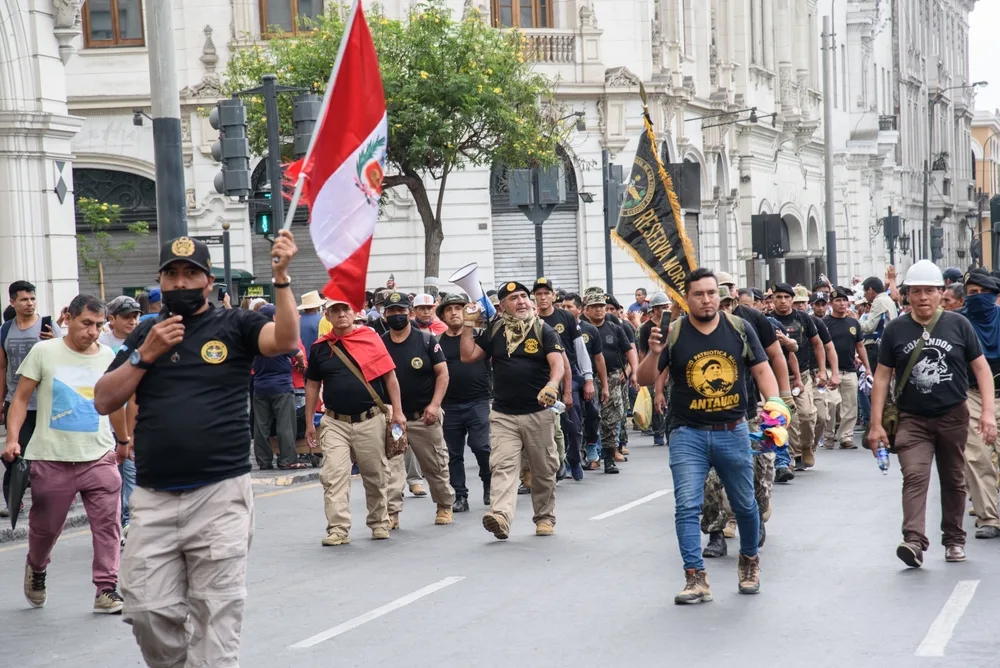
Lima, Peru: December 15, 2022: Demonstrators arrive in downtown Lima to express their rejection of the government of President Dina Boluarte in Peru/Joel Salvador/Shutterstock
Most tourists to Lima are concerned with the crime rate, especially given the city’s somewhat violent reputation. This reputation is backed up by the figures.
Peru, in general, has an elevated crime rate. According to World Bank data, as of 2018, the homicide rate in Peru was eight incidents per 100,000 people, a moderately high number. It’s normal that the capital and largest city would also have an elevated crime rate.
The State Department shared some crime statistics about Lima specifically that are also concerning. Eleven people are mugged every hour in Lima.
Over 500 people were murdered in 2021, which translates to almost two murders per day. The statistics aren’t just in place to frighten tourists. Many Lima residents are affected by the high rate of crime in their city.
In a survey of residents and ex-pats, the site Cost of Living found that 84.12% consider that the level of crime is a problem, 78.68% worry about being mugged or robbed, and 82.05% worry about being the victim of a violent crime.
People also have a high degree of mistrust in authority figures, with 90.64% reporting problems with corruption and bribery.
Considering that it is common for police officers themselves to extort civilians, it’s no wonder that the level of mistrust is so high. It also means that people don’t always trust the authorities to help them if they are victims of a crime.
Part of the reason why Lima’s crime rate is so high is that the city is very unequal, but that sometimes works in favor of tourists. Most violent crime is concentrated in poorer, run-down areas where tourists rarely go.
However, criminals also operate in the wealthier, touristy parts of Lima, as that is where they find good targets. If you decide to visit Lima, you should be on alert wherever you go.
Theft
Sadly, theft is a common problem in Lima. Thefts range from pickpocketing to vehicle break-ins to muggings. The problem starts as soon as you arrive at Lima’s Jorge Chavez International Airport.
Thieves take advantage of unattended luggage or pose as taxi drivers and lure tourists away to charge extortion amounts of money.
The problem has gotten better since Peruvian authorities temporarily banned people from entering the airport if they are not ticketed travelers (although that is a sign of worse problems).
In general, never leave luggage unattended and only take authorized taxi services. Pickpocketing and bag snatching are common crimes throughout Lima. Pickpockets operate on public transportation, in downtown Lima, and around popular tourist attractions such as Plaza de Armas.
Motorcycle thefts are also common — these are thefts when thieves on motorcycles ride quickly through crowded areas and snatch bags from people on the sidewalk. Always carry your handbag or backpack on the side away from the street.
Be extra vigilant about keeping your valuables close. Never carry your wallet in your back pocket or in the outside pockets of a backpack. Keep purses close to your body under the crook of your arm.
Don’t use your phone in public; use a paper map or ask for directions. In general, avoid flashing valuables. It makes you a target, and it is a bit insensitive, given the high poverty rates in the city.
Scams are also quite common. Beware of money changers in the market as they will take some of your cash or pass you counterfeit bills. As with any other tourist destination, be careful of people approaching you and making a scene to distract you while an accomplice robs you.
Another common scam targeting older people is the “grandparent scam,” when someone approaches you or calls you claiming that a grandchild is in trouble and needs money wired through Western Union quickly.
Walking around Lima definitely requires a bit more precautions than walking around your hometown, especially if you want to get home with all of your valuables.
Armed Robbery
Some petty theft is easy to deal with, but the real danger for tourists in Lima is the high rate of violent crimes, including armed robbery and assault.
Taxis are a surprisingly common location for armed robberies. Never hail a taxi from the street in Lima, as many are just posing as taxis and are unauthorized companies. These taxis will take you to a hidden location and then rob you.
Even if you are in a reputable taxi company, you are in danger of armed robbery while you are on the road. Violent robbers will sometimes smash windows while you are sitting in traffic and snatch valuables located within.
Always keep bags in the trunk or glove compartment so you don’t single yourself out as a target. Avoid driving or taking a taxi in unfamiliar places at night as criminal groups sometimes set up roadblocks to rob people according to the State Department advisories.
Robberies at gunpoint also occur throughout the city of Lima. Although most violent crimes occur in poorer, crime-ridden areas, they can happen everywhere.
The government of the United Kingdom advised its citizens to be careful after several of its citizens were robbed at gunpoint outside of their hotels in the upscale districts of Miraflores and Barranco, hardly crime-ridden locations.
ATMs are also places where violent robberies happen fairly often. Muggers will perform “express kidnappings,” which is when they rob people at gunpoint, forcing them to empty their ATM accounts and only then letting them go.
Avoid using ATMs at night or outside — only use the ones inside banks. Sadly, another form of violent crime that is common is sexual assault.
There have been situations where foreign female tourists were assaulted. Be especially vigilant when accepting drinks in bars and clubs, as spiked drinks are very common.
Avoiding Bad Areas
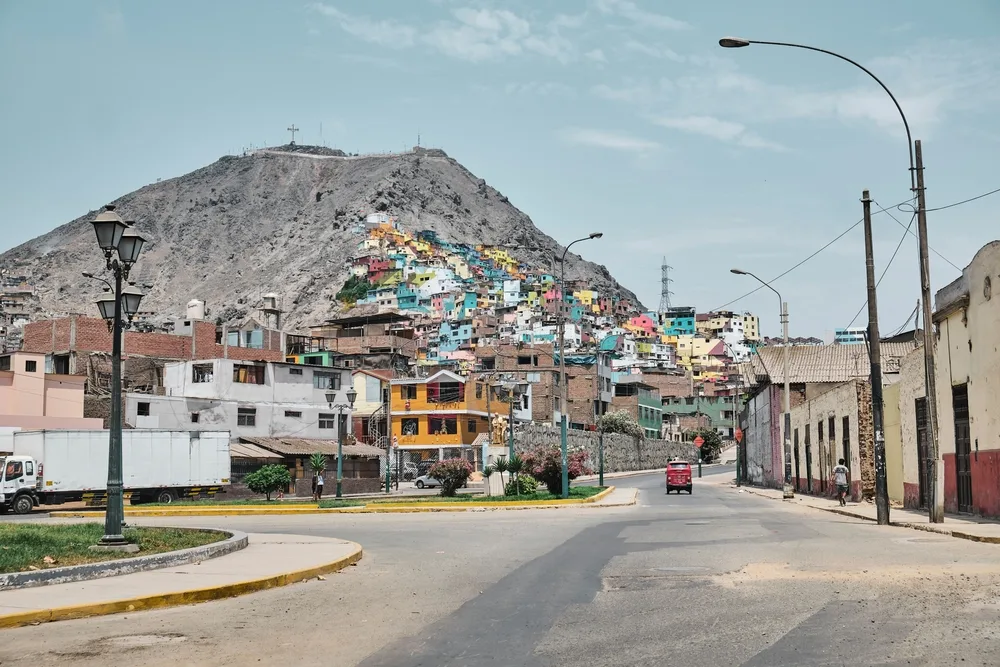
Lima, Peru – January 02, 2022: The road leading to the hill with the slums in a disadvantaged area of the city/Badahos/Shutterstock
Although crime can happen anywhere in Lima, there are certain neighborhoods that have much higher crime rates than others. Avoiding those neighborhoods can help you protect yourself from crime.
Locals caution tourists against walking around La Victoria, Barrios Altos, and El Callao. Callao is Lima’s major port (technically within the metropolitan area, not the city itself) and a hotspot for crime. Other dangerous areas include San Juan de Lurigancho and Ate Vitarte.
The Centro Historico is also not the safest neighborhood, as thieves know it has a lot of tourists. The center also borders a lot of dangerous neighborhoods, so be careful that you don’t wander down a bad side street by accident.
Be careful on the roads as well, especially the road from the airport to the town. These are hotspots for armed robbery or smash-and-grab burglaries when vehicles get stuck in traffic.
Things to Consider
Here are some other things to keep in mind to ensure your safety in Lima:
- Be careful when sampling the famous street food. Trust your instincts if you think a vendor’s set-up doesn’t look hygienic.
- Make sure your hotel or hostel has good security, especially if you are a woman traveling alone.
- Carrying photo identification is mandatory by law, but you don’t want to risk your passport getting stolen. Carry a copy of your passport, just in case.
Frequently Asked Questions
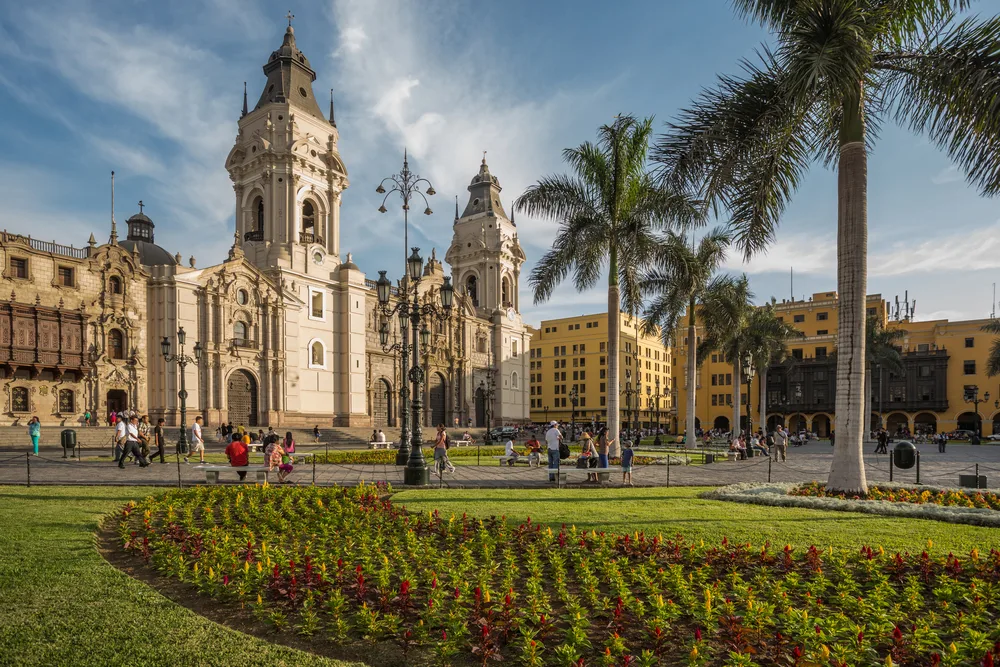
Christian Vinces/Shutterstock
Still have more questions about your visit to Lima? Here are our answers:
Is Lima, Peru safe to tourists?
Lima, Peru, has its dangers for tourists, especially as foreigners are often targets for theft and other forms of crime. Right now, civil unrest could also disturb tourists caught in the whirlwind.
What should you avoid in Lima?
If you want to stay safe in Lima, avoid dangerous neighborhoods, especially slums such as Comas and Villa Salvador. Avoid flashing your valuables. Avoid becoming complacent and making decisions such as taking unverified taxis.
Is Lima, Peru worth visiting?
With so many precautions that you need to take, you might be wondering why people visit Lima at all. The reason is that Lima, Peru, is well worth visiting due to the gorgeous architecture, delicious food, vibrant culture, and easy connections to the rest of Peru’s popular sites.
Is it safe to walk at night in Lima?
No, it’s not safe to walk in Lima at night, as violent crime happens even in rich, safe neighborhoods. Walk in groups or take an authorized taxi.
Is Lima safe for solo female travelers?
Many female travelers still visit Lima, but they have to take extra precautions if traveling alone. Limit your exploring to the daytime unless you are joining a group, and trust your instincts about when to leave a hairy situation.
So, Is Lima Safe to Visit?
Due to a high risk of civil unrest in the capital, we don’t think that Lima, Peru is not safe to visit right now. Visitors also need to be vigilant about the city’s high crime rate.
But this is just the situation right now. It can change at any moment, and when it does, you’ll eventually be able to experience the amazing beauty and food that the city has to offer.



